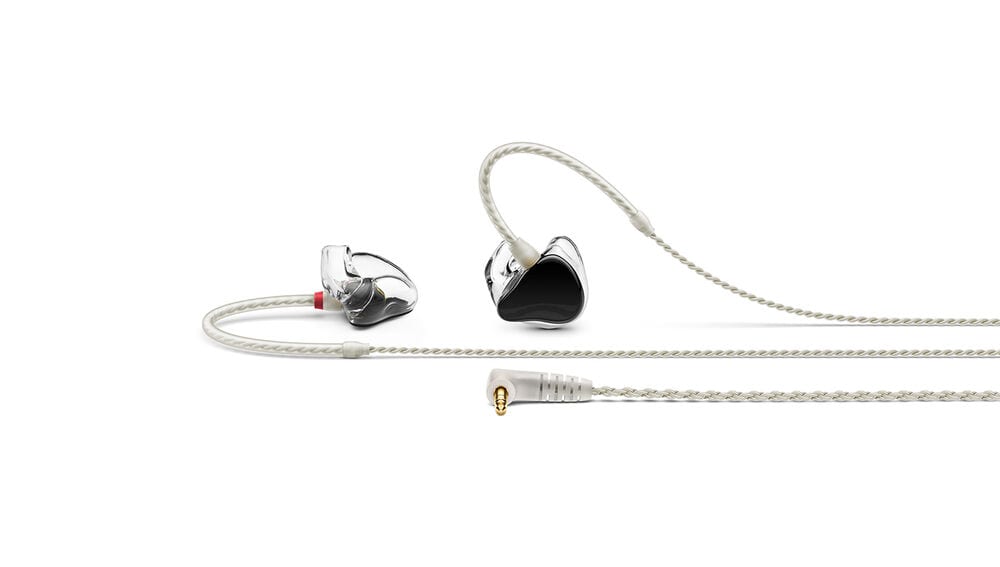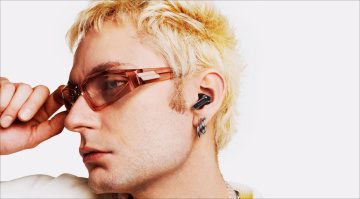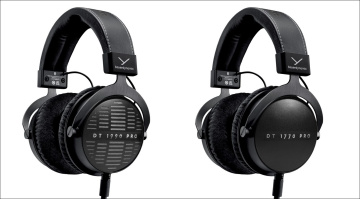In-Ear Monitoring for DJs 2025: More Control, Less Ear Strain – the Path to Better Mixes!
It Keeps the Sound Consistent and Protects Your Ears, No Matter How Loud the Club is
In-ear monitoring has evolved from a niche solution to a serious alternative to classic DJ headphones in recent years. More and more artists are turning to this technology to ensure clear, consistent monitoring during loud club nights, open-air festivals, and long sets. The advantage is clear: rather than trying to hear over the booth monitors, the sound goes directly into your ears – precise and defined without unnecessary volume. Here’s an overview.
All About In-Ear Monitoring for DJs
In-Ear Monitoring for DJs Offers Precision, Protection, and Comfort in the DJ Booth
In-ear monitoring is no longer a niche solution, but rather a serious alternative to classic DJ headphones. More and more artists are using this technology to more accurately hear themselves in the booth, improve their hearing protection, and take their personal monitoring to a new level. This trend is not just about fashion preferences but also about the sound benefits and health aspects that are crucial in loud club environments.
Anyone who has DJed with professional in-ear headphones before will quickly notice how clearly even the smallest details in the mix can be heard. Bass lines, hi-hats, and effects sound cleanly separated, allowing for more precise and creative transitions. At the same time, the required volume in the ear is reduced because external noise is muffled. This protects your hearing — something many DJs only appreciate when they experience the first signs of hearing fatigue.
Despite all the advantages, switching is not easy for everyone. Many DJs initially find in-ear monitoring “dry” and miss the direct pressure of a monitor speaker. Additionally, the audience’s perception changes because the sound from the main PA no longer reaches their ears unfiltered. However, with the right technology and suitable in-ear monitors, this issue can be significantly mitigated, allowing the advantages to outweigh the disadvantages.
In-Ear Monitoring for DJs – the Right Fit: Standard Earpieces or Earmolds
The basis for effective in-ear monitoring is a perfect fit. Standard in-ear headphones come with various silicone or foam attachments. While these are flexible, they do not always provide a perfect seal. This is a good place to start for many, but those who play often and are looking for maximum comfort will sooner or later consider custom-made ear molds.
With this option, an impression of the ear canal is taken to ensure a perfect fit. The advantages are better sealing against external noise and a stable fit, even during rapid head movements. For DJs, this means monitoring remains stable during energetic sets, and no background noise disturbs them.
However, ear molds are more expensive. The investment is worth it, though, as the sound is more direct, the bass pressure is more stable, and they are significantly more comfortable during long performances. This option also allows you to exploit the full potential of your chosen in-ear model.
Sound and Frequency Response are Crucial for In-Ear Monitoring for DJs
Whether standard or custom, the sound character is crucial. A balanced frequency response with powerful bass is important so that beats and kick drums aren’t lost in a club environment. At the same time, the mids and highs should be clearly defined so that vocals, effects, and melodies can be heard precisely.
Some manufacturers use multi-way systems, where several drivers cover different frequency ranges. Models such as the Ultimate Ears UE-6 Pro have a powerful low end and clear highs, and models such as the Hörluchs HL1050 have maximum transparency. DJs who mainly play electronic music often prefer models with emphasized bass, while open-format DJs prefer a neutral sound.
Durability is also important. In-ear headphones for professional use must reproduce high levels cleanly without distortion. Values above 115 dB SPL are not uncommon but should only be used in exceptional cases to avoid hearing damage.
Examples of In-Ear Monitoring for DJs and Headphones for Everyday Use
Audio-Technica ATH-E70
These in-ear headphones* offer a detailed, linear sound, which is ideal for precise beat matching. Their clear midrange reproduction makes it easier to separate vocals and instruments. These headphones are a good choice for analytical DJs. One disadvantage is that the neutral sound may seem too restrained for bass lovers.
Hörluchs Universal Supreme HL4410
The HL4410 is a model with powerful bass and a balanced sound. Its advantages are its high-level stability and sturdy construction, which impress even at festivals. A minor drawback is its slightly higher weight, which may be noticeable during very long sets.
Ultimate Ears UE-6 Pro
Ideal for DJs, offering rich low-end punch and clear highs. The custom ear molds fit perfectly, ensuring maximum comfort. One drawback is the high price, which may deter beginners.
Sennheiser IE 100 Pro Clear:
An affordable but solid solution* as in-ear monitoring for DJs looking to get started with. The powerful sound and present bass are advantages, though the treble sometimes seems a little soft. Nevertheless, it is a reliable choice for mobile DJs and smaller clubs.
Shure SE215 Pro CL
This classic* scores with its warm sound characteristics and very good external sound insulation. It’s a solid choice for electronic music, though the richness of detail in the treble range doesn’t quite match that of more expensive models.
Behringer SD251-CL
This affordable entry-level model* still delivers decent results. Its advantages clearly lie in its price-performance ratio; however, the detail resolution is limited compared to premium models. It’s perfect for beginners or as a replacement pair.
Hörluchs HL1050
A precise 2-way system* with brilliant highs and clear mids. It is ideal for DJs who value transparency above all else. However, the rather neutral bass range may seem too restrained for bassheads.
The t.bone EP 4 in-ear headphones
It’s affordable*, robust, and has a surprisingly powerful bass range. Disadvantages include the somewhat limited spatiality and the non-replaceable cable connection.
StageDiver SD-5:
A high-end model* for the most demanding users. It is extremely detailed, has a perfect fit, and provides excellent isolation. The only drawback is the high price.
In-Ear Monitoring for DJs: Tips & Tricks
If you want to use in-ear monitoring properly as a DJ, you should establish a consistent routine. This includes setting the master and cue mix so that there is always sufficient reference to the main PA. Some mixers offer split monitoring, where the master and cue are on separate sides of the stereo signal. This method has proven particularly effective.

It’s also important to hear your own voice through the in-ear mix when presenting, to avoid unnatural intonation. Ambient functions or slightly open fits can help you pick up more of the club atmosphere without sacrificing hearing protection.
Stay Connected and in the Moment
To avoid being completely cut off from the outside world when using in-ear monitoring as a DJ, use an additional microphone. Position this microphone to capture audience reactions and the room’s atmosphere. The recorded signal is fed directly into your in-ear mix, so the sound remains protected while you maintain an awareness of the room and the mood. This creates a much more natural listening experience, especially in large clubs or at open-air festivals, making the mix sound more organic.
In practice, you can use the compact Shure Beta 98H/C condenser microphone or the robust Audio-Technica PRO 45 microphone (any other mic will work too). Both can be placed inconspicuously in the booth or on the DJ console without disrupting the workflow. Connect the microphone to a free channel or aux input on the DJ mixer, then mix it into the in-ear path.
The advantage is obvious: You can adjust the volume at any time, and even with maximum isolation of the in-ear monitors, you can maintain an emotional connection to the audience. Although this setup requires extra technical effort, it offers significant advantages for your performance.
To ensure optimal performance, this microphone setup should be carefully integrated into the mixer. Ideally, the microphone should be assigned to a separate channel and equipped with a low-cut filter to minimize low-frequency noise, such as footfall or bass rumble. Set the volume so that ambient noise is clear but not dominant. If your mixer has a flexible routing matrix, you can send the signal directly to your in-ear channel without making it audible on the PA system.
Using an aux send is particularly practical here because it allows you to adjust the level independently of the main mix. This method allows you to control monitoring and ensure hearing protection while still being able to hear the energy of the crowd.
In-Ear Monitoring for DJs – Conclusion: Is it Worth the Switch?
In-ear monitoring isn’t a panacea for DJs, but it can elevate personal monitoring in clubs or at festivals. Those willing to embrace a different listening experience and invest in the right equipment will enjoy clearer sound, better level control, and healthier hearing in the long term. It takes some getting used to, but it quickly pays off with frequent use and in loud environments.
More Information About In-Ear Monitoring for DJs
*Note: This article on in-ear monitoring for DJs contains affiliate links that help fund our site. Don’t worry – the price remains the same for you! If you purchase something through these links, we receive a small commission. Thank you for your support!

 5,0 / 5,0 |
5,0 / 5,0 | 







